Partner Visa Application Analysis: Le v Minister for Immigration Case
VerifiedAdded on 2022/08/12
|11
|3042
|27
Case Study
AI Summary
This assignment analyzes the case of Le v Minister for Immigration [2019] FCCA 2167, which concerns a partner visa application. The case involves a Vietnamese applicant, Ms. Le, seeking judicial review of the Minister's decision to dismiss her partner visa application. The analysis examines the facts, focusing on the couple's relationship, the initial visa application, and the subsequent rejection due to a 'No Further Stay' condition on the visitor visa. It delves into the legal rules and principles, particularly the Migration Act and regulations, including Section 7A and the implications of the visitor visa conditions. The assignment explores the delegate's initial decisions, the judicial review's findings, and the Minister's stance on the waiver application. It also discusses the relevant visa laws, including subclass 600 and 820, and examines the court's reasoning in determining the validity of the decisions made by the delegate. The analysis concludes that the judicial review found the delegate's decision legally unreasonable, primarily due to a statutory impediment rather than the application's incompleteness. The assignment highlights the importance of providing sufficient evidence to prove the genuineness of the relationship in a partner visa application.

Running head: ANALYSIS OF PARTNER VISA
Immigration
Student’s Name
Institution
Date
Immigration
Student’s Name
Institution
Date
Paraphrase This Document
Need a fresh take? Get an instant paraphrase of this document with our AI Paraphraser
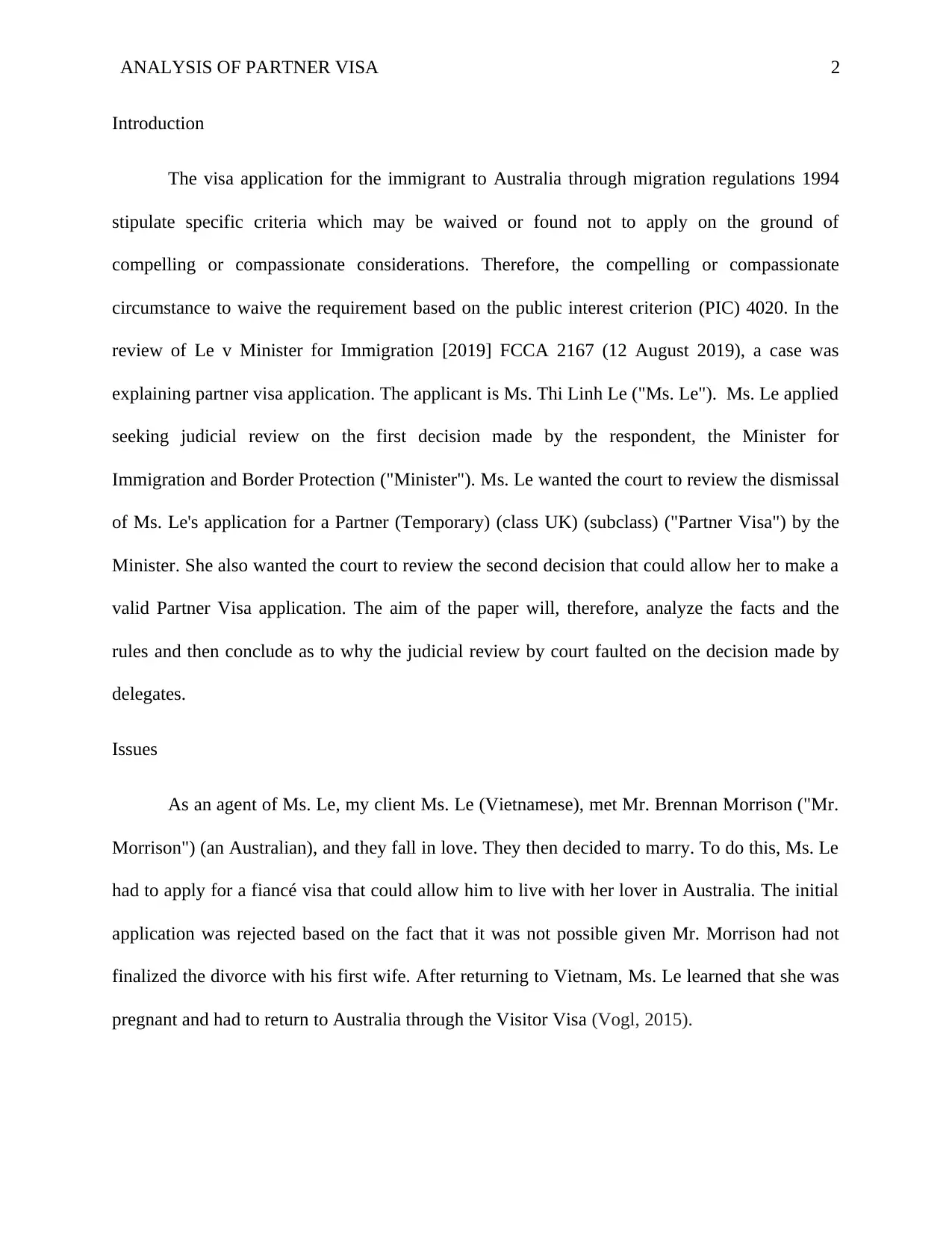
ANALYSIS OF PARTNER VISA 2
Introduction
The visa application for the immigrant to Australia through migration regulations 1994
stipulate specific criteria which may be waived or found not to apply on the ground of
compelling or compassionate considerations. Therefore, the compelling or compassionate
circumstance to waive the requirement based on the public interest criterion (PIC) 4020. In the
review of Le v Minister for Immigration [2019] FCCA 2167 (12 August 2019), a case was
explaining partner visa application. The applicant is Ms. Thi Linh Le ("Ms. Le"). Ms. Le applied
seeking judicial review on the first decision made by the respondent, the Minister for
Immigration and Border Protection ("Minister"). Ms. Le wanted the court to review the dismissal
of Ms. Le's application for a Partner (Temporary) (class UK) (subclass) ("Partner Visa") by the
Minister. She also wanted the court to review the second decision that could allow her to make a
valid Partner Visa application. The aim of the paper will, therefore, analyze the facts and the
rules and then conclude as to why the judicial review by court faulted on the decision made by
delegates.
Issues
As an agent of Ms. Le, my client Ms. Le (Vietnamese), met Mr. Brennan Morrison ("Mr.
Morrison") (an Australian), and they fall in love. They then decided to marry. To do this, Ms. Le
had to apply for a fiancé visa that could allow him to live with her lover in Australia. The initial
application was rejected based on the fact that it was not possible given Mr. Morrison had not
finalized the divorce with his first wife. After returning to Vietnam, Ms. Le learned that she was
pregnant and had to return to Australia through the Visitor Visa (Vogl, 2015).
Introduction
The visa application for the immigrant to Australia through migration regulations 1994
stipulate specific criteria which may be waived or found not to apply on the ground of
compelling or compassionate considerations. Therefore, the compelling or compassionate
circumstance to waive the requirement based on the public interest criterion (PIC) 4020. In the
review of Le v Minister for Immigration [2019] FCCA 2167 (12 August 2019), a case was
explaining partner visa application. The applicant is Ms. Thi Linh Le ("Ms. Le"). Ms. Le applied
seeking judicial review on the first decision made by the respondent, the Minister for
Immigration and Border Protection ("Minister"). Ms. Le wanted the court to review the dismissal
of Ms. Le's application for a Partner (Temporary) (class UK) (subclass) ("Partner Visa") by the
Minister. She also wanted the court to review the second decision that could allow her to make a
valid Partner Visa application. The aim of the paper will, therefore, analyze the facts and the
rules and then conclude as to why the judicial review by court faulted on the decision made by
delegates.
Issues
As an agent of Ms. Le, my client Ms. Le (Vietnamese), met Mr. Brennan Morrison ("Mr.
Morrison") (an Australian), and they fall in love. They then decided to marry. To do this, Ms. Le
had to apply for a fiancé visa that could allow him to live with her lover in Australia. The initial
application was rejected based on the fact that it was not possible given Mr. Morrison had not
finalized the divorce with his first wife. After returning to Vietnam, Ms. Le learned that she was
pregnant and had to return to Australia through the Visitor Visa (Vogl, 2015).
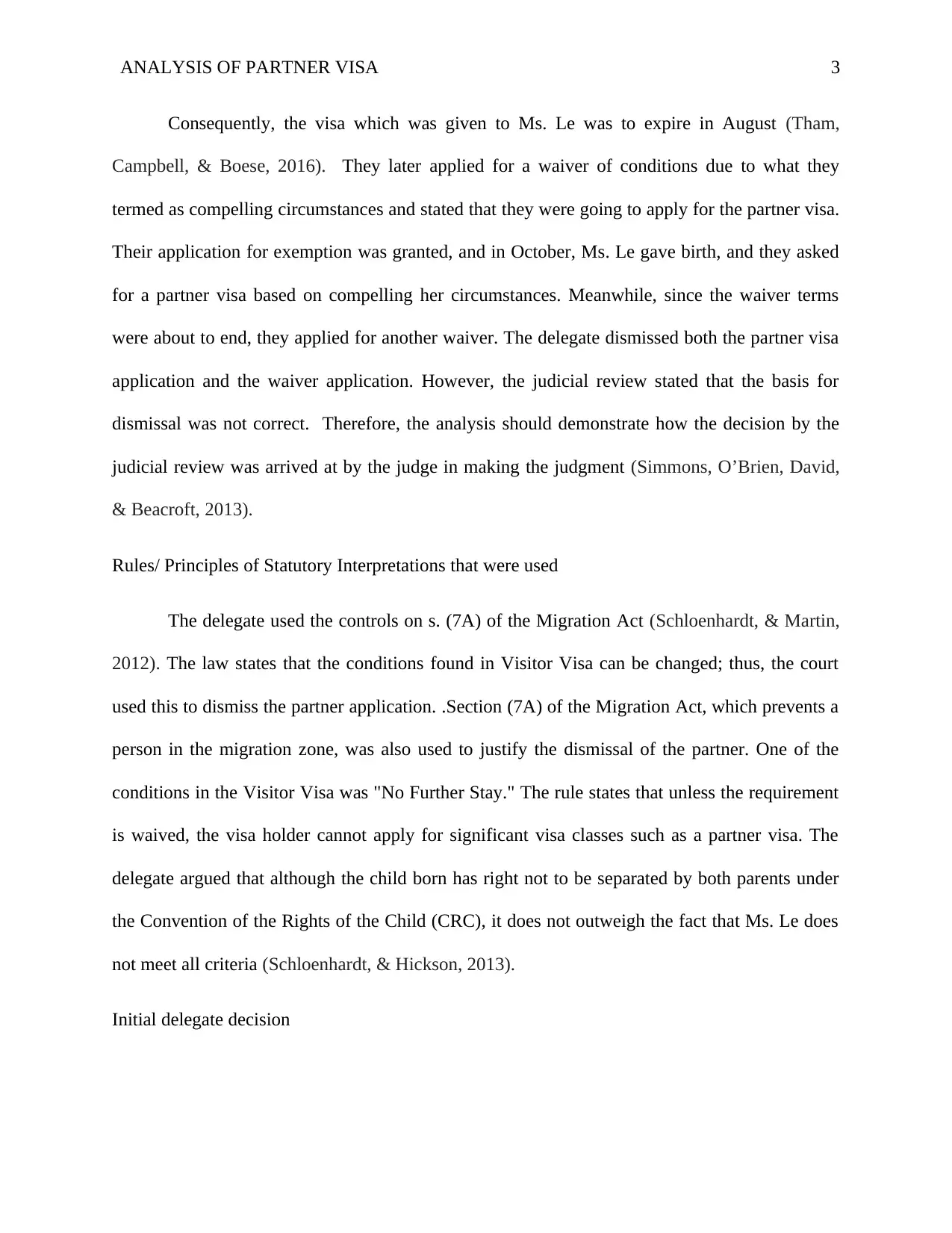
ANALYSIS OF PARTNER VISA 3
Consequently, the visa which was given to Ms. Le was to expire in August (Tham,
Campbell, & Boese, 2016). They later applied for a waiver of conditions due to what they
termed as compelling circumstances and stated that they were going to apply for the partner visa.
Their application for exemption was granted, and in October, Ms. Le gave birth, and they asked
for a partner visa based on compelling her circumstances. Meanwhile, since the waiver terms
were about to end, they applied for another waiver. The delegate dismissed both the partner visa
application and the waiver application. However, the judicial review stated that the basis for
dismissal was not correct. Therefore, the analysis should demonstrate how the decision by the
judicial review was arrived at by the judge in making the judgment (Simmons, O’Brien, David,
& Beacroft, 2013).
Rules/ Principles of Statutory Interpretations that were used
The delegate used the controls on s. (7A) of the Migration Act (Schloenhardt, & Martin,
2012). The law states that the conditions found in Visitor Visa can be changed; thus, the court
used this to dismiss the partner application. .Section (7A) of the Migration Act, which prevents a
person in the migration zone, was also used to justify the dismissal of the partner. One of the
conditions in the Visitor Visa was "No Further Stay." The rule states that unless the requirement
is waived, the visa holder cannot apply for significant visa classes such as a partner visa. The
delegate argued that although the child born has right not to be separated by both parents under
the Convention of the Rights of the Child (CRC), it does not outweigh the fact that Ms. Le does
not meet all criteria (Schloenhardt, & Hickson, 2013).
Initial delegate decision
Consequently, the visa which was given to Ms. Le was to expire in August (Tham,
Campbell, & Boese, 2016). They later applied for a waiver of conditions due to what they
termed as compelling circumstances and stated that they were going to apply for the partner visa.
Their application for exemption was granted, and in October, Ms. Le gave birth, and they asked
for a partner visa based on compelling her circumstances. Meanwhile, since the waiver terms
were about to end, they applied for another waiver. The delegate dismissed both the partner visa
application and the waiver application. However, the judicial review stated that the basis for
dismissal was not correct. Therefore, the analysis should demonstrate how the decision by the
judicial review was arrived at by the judge in making the judgment (Simmons, O’Brien, David,
& Beacroft, 2013).
Rules/ Principles of Statutory Interpretations that were used
The delegate used the controls on s. (7A) of the Migration Act (Schloenhardt, & Martin,
2012). The law states that the conditions found in Visitor Visa can be changed; thus, the court
used this to dismiss the partner application. .Section (7A) of the Migration Act, which prevents a
person in the migration zone, was also used to justify the dismissal of the partner. One of the
conditions in the Visitor Visa was "No Further Stay." The rule states that unless the requirement
is waived, the visa holder cannot apply for significant visa classes such as a partner visa. The
delegate argued that although the child born has right not to be separated by both parents under
the Convention of the Rights of the Child (CRC), it does not outweigh the fact that Ms. Le does
not meet all criteria (Schloenhardt, & Hickson, 2013).
Initial delegate decision
⊘ This is a preview!⊘
Do you want full access?
Subscribe today to unlock all pages.

Trusted by 1+ million students worldwide

ANALYSIS OF PARTNER VISA 4
The visa application in Australia is based on jurisdiction made in Australia. For instance,
the first decision, according to Australia, indicates that the visa becomes invalid when the
applicant is subjected to Visitor Visa overstayed in Australia without stating prompt reason
afterward (Vrachnas, Bagaric, Dimopoulos, & Pathinayake, 2011). Consequently, my client that
is Ms. Le, who initially applied Visitor Visa to pass, later reapplied for the partner visa.
However, based on precise circumstances that coincidently meet Ms. Le, I request on behalf of
her so that she can be granted justice just like any local citizen of Australia (Pickering, & Weber,
2012). Through the interpretation of the validity of visa application, as illustrated in the section
(7A) of the migration Act, shows that the Visa application is valid if the visitor stays within the
migration zone and will not grant any other substantive visa, while the holder remains in
Australia. Accordingly, my point of clarification about my client is still not violated any law
based on the fact she is having unborn, who is a citizen of Australia by birth (Opeskin, 2012).
However, Ms. Le asked the court for judicial review. The judicial review used most of
the sections from the Migration Act and regulations to make the judgment. Concerning the law
of the land and under the jurisdiction of the Australia authority, it clear that the Visitor visa,
which is subjected to the condition and someone has no control over them, is treated differently.
This is in line with 8(8) (b) of the regulatory acts. Therefore, as an agent of the victim, I feel a
further review should be rendered to my client (Klein, 2014).
Decision made by Minister
As cited by Horner, Wood, and Kelly, (2013) reiterated that Partner Visa application was
invalid. This is because the waiver application had not been granted before the lodgment of the
Partner Visa application. It was established of the Migration Act only deals with how to decide
the validity of the certificate and not the decision on whether to grant or refuse the visa. This act
The visa application in Australia is based on jurisdiction made in Australia. For instance,
the first decision, according to Australia, indicates that the visa becomes invalid when the
applicant is subjected to Visitor Visa overstayed in Australia without stating prompt reason
afterward (Vrachnas, Bagaric, Dimopoulos, & Pathinayake, 2011). Consequently, my client that
is Ms. Le, who initially applied Visitor Visa to pass, later reapplied for the partner visa.
However, based on precise circumstances that coincidently meet Ms. Le, I request on behalf of
her so that she can be granted justice just like any local citizen of Australia (Pickering, & Weber,
2012). Through the interpretation of the validity of visa application, as illustrated in the section
(7A) of the migration Act, shows that the Visa application is valid if the visitor stays within the
migration zone and will not grant any other substantive visa, while the holder remains in
Australia. Accordingly, my point of clarification about my client is still not violated any law
based on the fact she is having unborn, who is a citizen of Australia by birth (Opeskin, 2012).
However, Ms. Le asked the court for judicial review. The judicial review used most of
the sections from the Migration Act and regulations to make the judgment. Concerning the law
of the land and under the jurisdiction of the Australia authority, it clear that the Visitor visa,
which is subjected to the condition and someone has no control over them, is treated differently.
This is in line with 8(8) (b) of the regulatory acts. Therefore, as an agent of the victim, I feel a
further review should be rendered to my client (Klein, 2014).
Decision made by Minister
As cited by Horner, Wood, and Kelly, (2013) reiterated that Partner Visa application was
invalid. This is because the waiver application had not been granted before the lodgment of the
Partner Visa application. It was established of the Migration Act only deals with how to decide
the validity of the certificate and not the decision on whether to grant or refuse the visa. This act
Paraphrase This Document
Need a fresh take? Get an instant paraphrase of this document with our AI Paraphraser

ANALYSIS OF PARTNER VISA 5
prohibits the delegate from considering and determining whether to grant or deny the Partner
Visa. After analyzing the first and second decision, the court concluded that there was nothing
incomplete in Ms. Le's application.
In reality, Ms. Le was eligible, but the process was hindered by the inability of the
delegate to waive the Visitor Visa. As per the act, spousal immigration generally involves two
steps (Hirsch, (2017). First, be granted spouse temporary residence visa; if the spouse
relationship continues and other conditions are met, you can obtain a permanent residency visa
after about two years.
Based on the information obtained from Australia minister of migration indicates that
appeal from the decision of the federal circuit court of Australia dismissing the application for
judicial review of immigration. Therefore, the evaluation authority decision of the Minister's
delegate declining to permit haven enterprise visa-whether authority failed to apply section
473DD of the migration Act 1958 by the taking information as submission (Grewcock, 2017).
According to the Administrative Appeals Tribunal Act 1975 (Cth), s 44 shows that the
spouse relationship can be marriage or cohabitation. So the reviewer's goal was not to determine
the decision to grant or refuse a visa was legally done or not. However, this will handle the issue
of whether the failure of the delegate to waive the application was reasonable or not (Grewcock,
2013).
Was the first decision legally reasonable?
First, we have demonstrated that the critical issue faced by the judicial review committee
was not to determine the validity of the second decision but to evaluate whether the first decision
was valid or not. The Minister established that the delegate refusal to grant waiver was
prohibits the delegate from considering and determining whether to grant or deny the Partner
Visa. After analyzing the first and second decision, the court concluded that there was nothing
incomplete in Ms. Le's application.
In reality, Ms. Le was eligible, but the process was hindered by the inability of the
delegate to waive the Visitor Visa. As per the act, spousal immigration generally involves two
steps (Hirsch, (2017). First, be granted spouse temporary residence visa; if the spouse
relationship continues and other conditions are met, you can obtain a permanent residency visa
after about two years.
Based on the information obtained from Australia minister of migration indicates that
appeal from the decision of the federal circuit court of Australia dismissing the application for
judicial review of immigration. Therefore, the evaluation authority decision of the Minister's
delegate declining to permit haven enterprise visa-whether authority failed to apply section
473DD of the migration Act 1958 by the taking information as submission (Grewcock, 2017).
According to the Administrative Appeals Tribunal Act 1975 (Cth), s 44 shows that the
spouse relationship can be marriage or cohabitation. So the reviewer's goal was not to determine
the decision to grant or refuse a visa was legally done or not. However, this will handle the issue
of whether the failure of the delegate to waive the application was reasonable or not (Grewcock,
2013).
Was the first decision legally reasonable?
First, we have demonstrated that the critical issue faced by the judicial review committee
was not to determine the validity of the second decision but to evaluate whether the first decision
was valid or not. The Minister established that the delegate refusal to grant waiver was

ANALYSIS OF PARTNER VISA 6
unreasonable because the delegate found or assumed, incorrectly and without any or any
adequate evidence for any such findings (Curley, & Vandyk, 2017). In simple terms, the
condition highlighted in PAM3 will often be relevant to the evaluation of the waiver. The
tribunal should have ensured that circumstances of the applicant's compelling reasons are not
limited to the condition surrounding their unlawful status. Therefore, it should be undefeatable if
the case, including the escalating after the application of the visa, should be met by a precise,
transparent means of the judgment. This is so to ensure that the matter which is put forward by
an applicant is achieved based on the evidence. Furthermore, it would seem to improperly edge
the circumstances contemplated in cl.820.211 (2) (d) (ii) to require that the details are beyond the
applicant's control (Crock, & Martin, 2013).
Visa law
There are two visa law which was used by the Australia court to justify the case of Ms.
Le. One of the visa law which was put into the consideration was the subclass 600, which
stipulate the four streams. Based on the case of Ms. Le, who was a visitor to Australia, the law
indicates that if a visitor applies for a visa for visiting purposes, then they must be in Australia
when the visa is decided (Crock & Kenny, 2012).
Secondly, the subclass 820 allows the partner or the spouse of the Australian citizen to
stay in Australia within the specified condition. The temporary subclass visa is issued first and
lets you stay in Australia; however, after twenty-four months of stay, one may be allowed to
apply for the permanent partner visa subclass 801. Under the subclass 820, the couple marriage
must be under Australia law, and they must also meet health and character requirements (Wood,
& McAdam, 2012).
unreasonable because the delegate found or assumed, incorrectly and without any or any
adequate evidence for any such findings (Curley, & Vandyk, 2017). In simple terms, the
condition highlighted in PAM3 will often be relevant to the evaluation of the waiver. The
tribunal should have ensured that circumstances of the applicant's compelling reasons are not
limited to the condition surrounding their unlawful status. Therefore, it should be undefeatable if
the case, including the escalating after the application of the visa, should be met by a precise,
transparent means of the judgment. This is so to ensure that the matter which is put forward by
an applicant is achieved based on the evidence. Furthermore, it would seem to improperly edge
the circumstances contemplated in cl.820.211 (2) (d) (ii) to require that the details are beyond the
applicant's control (Crock, & Martin, 2013).
Visa law
There are two visa law which was used by the Australia court to justify the case of Ms.
Le. One of the visa law which was put into the consideration was the subclass 600, which
stipulate the four streams. Based on the case of Ms. Le, who was a visitor to Australia, the law
indicates that if a visitor applies for a visa for visiting purposes, then they must be in Australia
when the visa is decided (Crock & Kenny, 2012).
Secondly, the subclass 820 allows the partner or the spouse of the Australian citizen to
stay in Australia within the specified condition. The temporary subclass visa is issued first and
lets you stay in Australia; however, after twenty-four months of stay, one may be allowed to
apply for the permanent partner visa subclass 801. Under the subclass 820, the couple marriage
must be under Australia law, and they must also meet health and character requirements (Wood,
& McAdam, 2012).
⊘ This is a preview!⊘
Do you want full access?
Subscribe today to unlock all pages.

Trusted by 1+ million students worldwide
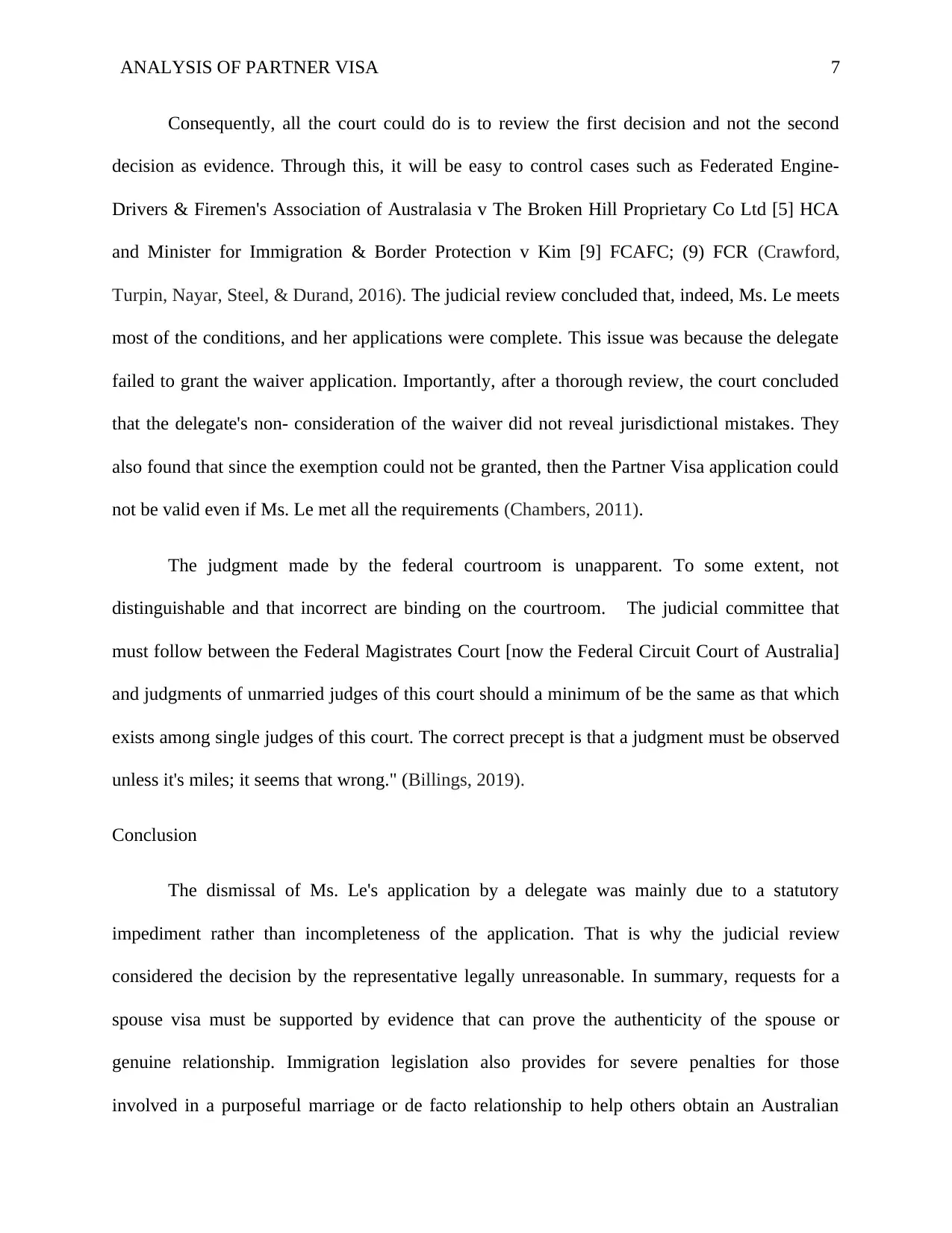
ANALYSIS OF PARTNER VISA 7
Consequently, all the court could do is to review the first decision and not the second
decision as evidence. Through this, it will be easy to control cases such as Federated Engine-
Drivers & Firemen's Association of Australasia v The Broken Hill Proprietary Co Ltd [5] HCA
and Minister for Immigration & Border Protection v Kim [9] FCAFC; (9) FCR (Crawford,
Turpin, Nayar, Steel, & Durand, 2016). The judicial review concluded that, indeed, Ms. Le meets
most of the conditions, and her applications were complete. This issue was because the delegate
failed to grant the waiver application. Importantly, after a thorough review, the court concluded
that the delegate's non- consideration of the waiver did not reveal jurisdictional mistakes. They
also found that since the exemption could not be granted, then the Partner Visa application could
not be valid even if Ms. Le met all the requirements (Chambers, 2011).
The judgment made by the federal courtroom is unapparent. To some extent, not
distinguishable and that incorrect are binding on the courtroom. The judicial committee that
must follow between the Federal Magistrates Court [now the Federal Circuit Court of Australia]
and judgments of unmarried judges of this court should a minimum of be the same as that which
exists among single judges of this court. The correct precept is that a judgment must be observed
unless it's miles; it seems that wrong." (Billings, 2019).
Conclusion
The dismissal of Ms. Le's application by a delegate was mainly due to a statutory
impediment rather than incompleteness of the application. That is why the judicial review
considered the decision by the representative legally unreasonable. In summary, requests for a
spouse visa must be supported by evidence that can prove the authenticity of the spouse or
genuine relationship. Immigration legislation also provides for severe penalties for those
involved in a purposeful marriage or de facto relationship to help others obtain an Australian
Consequently, all the court could do is to review the first decision and not the second
decision as evidence. Through this, it will be easy to control cases such as Federated Engine-
Drivers & Firemen's Association of Australasia v The Broken Hill Proprietary Co Ltd [5] HCA
and Minister for Immigration & Border Protection v Kim [9] FCAFC; (9) FCR (Crawford,
Turpin, Nayar, Steel, & Durand, 2016). The judicial review concluded that, indeed, Ms. Le meets
most of the conditions, and her applications were complete. This issue was because the delegate
failed to grant the waiver application. Importantly, after a thorough review, the court concluded
that the delegate's non- consideration of the waiver did not reveal jurisdictional mistakes. They
also found that since the exemption could not be granted, then the Partner Visa application could
not be valid even if Ms. Le met all the requirements (Chambers, 2011).
The judgment made by the federal courtroom is unapparent. To some extent, not
distinguishable and that incorrect are binding on the courtroom. The judicial committee that
must follow between the Federal Magistrates Court [now the Federal Circuit Court of Australia]
and judgments of unmarried judges of this court should a minimum of be the same as that which
exists among single judges of this court. The correct precept is that a judgment must be observed
unless it's miles; it seems that wrong." (Billings, 2019).
Conclusion
The dismissal of Ms. Le's application by a delegate was mainly due to a statutory
impediment rather than incompleteness of the application. That is why the judicial review
considered the decision by the representative legally unreasonable. In summary, requests for a
spouse visa must be supported by evidence that can prove the authenticity of the spouse or
genuine relationship. Immigration legislation also provides for severe penalties for those
involved in a purposeful marriage or de facto relationship to help others obtain an Australian
Paraphrase This Document
Need a fresh take? Get an instant paraphrase of this document with our AI Paraphraser
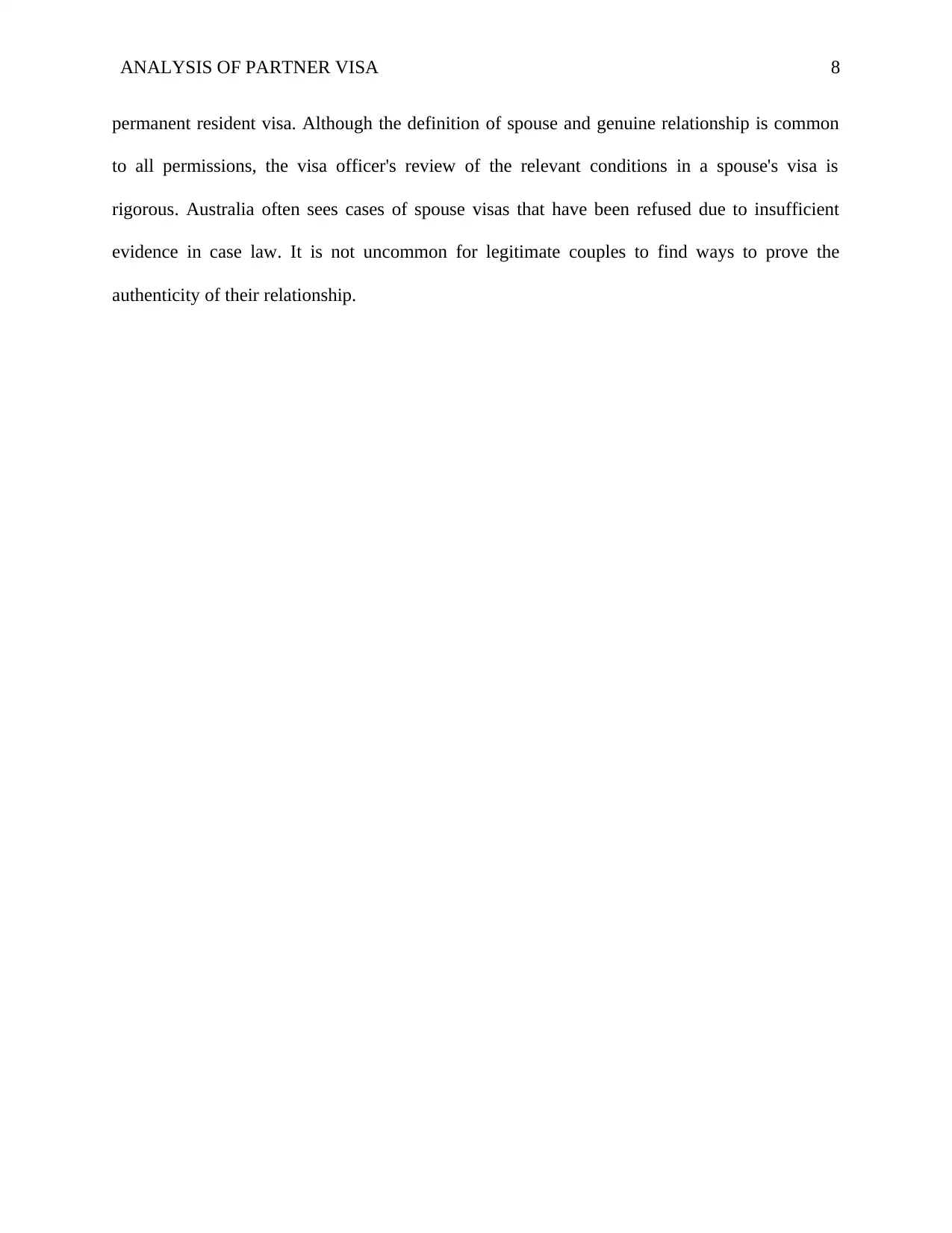
ANALYSIS OF PARTNER VISA 8
permanent resident visa. Although the definition of spouse and genuine relationship is common
to all permissions, the visa officer's review of the relevant conditions in a spouse's visa is
rigorous. Australia often sees cases of spouse visas that have been refused due to insufficient
evidence in case law. It is not uncommon for legitimate couples to find ways to prove the
authenticity of their relationship.
permanent resident visa. Although the definition of spouse and genuine relationship is common
to all permissions, the visa officer's review of the relevant conditions in a spouse's visa is
rigorous. Australia often sees cases of spouse visas that have been refused due to insufficient
evidence in case law. It is not uncommon for legitimate couples to find ways to prove the
authenticity of their relationship.

ANALYSIS OF PARTNER VISA 9
References
Billings, P. (2019). The Future of Law Reform: Simplification of the Migration Act 1958-
Submission to the Australian Law Reform Commission.
Chambers, P. (2011). Society has been defended: following the shifting shape of state through
Australia's Christmas Island. International Political Sociology, 5(1), 18-34.
Crawford, E., Turpin, M., Nayar, S., Steel, E., & Durand, J. L. (2016). The structural-personal
interaction: Occupational deprivation and asylum seekers in Australia. Journal of
Occupational Science, 23(3), 321-338.
Crock, M., & Kenny, M. A. (2012). Rethinking the guardianship of refugee children after the
Malaysian solution. Sydney L. Rev., 34, 437.
Crock, M., & Martin, H. (2013). Refugee rights and the merits of appeals. U. Queensland LJ, 32,
137.
Curley, M., & Vandyk, K. (2017). The securitisation of migrant smuggling in Australia and its
consequences for the Bali Process. Australian Journal of International Affairs, 71(1), 42-
62.
Grewcock, M. (2013). Australia’s ongoing border wars. Race & Class, 54(3), 10-32.
Grewcock, M. (2017). Reinventing ‘the stain’: Bad character and criminal deportation in
contemporary Australia. In The Routledge handbook on crime and international
migration (pp. 151-168). Routledge.
Hirsch, A. L. (2017). The borders beyond the border: Australia’s extraterritorial migration
controls. Refugee Survey Quarterly, 36(3), 48-80.
References
Billings, P. (2019). The Future of Law Reform: Simplification of the Migration Act 1958-
Submission to the Australian Law Reform Commission.
Chambers, P. (2011). Society has been defended: following the shifting shape of state through
Australia's Christmas Island. International Political Sociology, 5(1), 18-34.
Crawford, E., Turpin, M., Nayar, S., Steel, E., & Durand, J. L. (2016). The structural-personal
interaction: Occupational deprivation and asylum seekers in Australia. Journal of
Occupational Science, 23(3), 321-338.
Crock, M., & Kenny, M. A. (2012). Rethinking the guardianship of refugee children after the
Malaysian solution. Sydney L. Rev., 34, 437.
Crock, M., & Martin, H. (2013). Refugee rights and the merits of appeals. U. Queensland LJ, 32,
137.
Curley, M., & Vandyk, K. (2017). The securitisation of migrant smuggling in Australia and its
consequences for the Bali Process. Australian Journal of International Affairs, 71(1), 42-
62.
Grewcock, M. (2013). Australia’s ongoing border wars. Race & Class, 54(3), 10-32.
Grewcock, M. (2017). Reinventing ‘the stain’: Bad character and criminal deportation in
contemporary Australia. In The Routledge handbook on crime and international
migration (pp. 151-168). Routledge.
Hirsch, A. L. (2017). The borders beyond the border: Australia’s extraterritorial migration
controls. Refugee Survey Quarterly, 36(3), 48-80.
⊘ This is a preview!⊘
Do you want full access?
Subscribe today to unlock all pages.

Trusted by 1+ million students worldwide
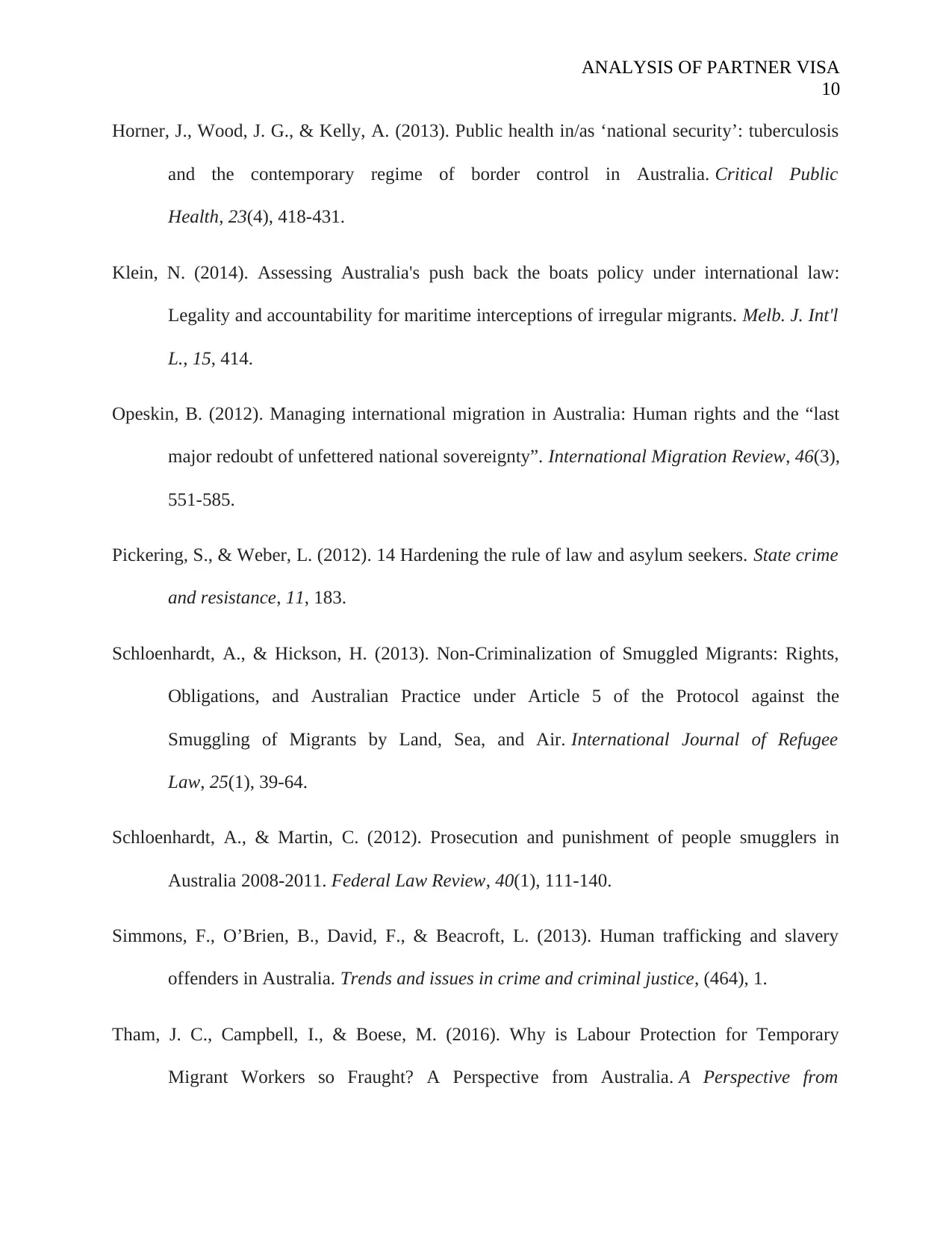
ANALYSIS OF PARTNER VISA
10
Horner, J., Wood, J. G., & Kelly, A. (2013). Public health in/as ‘national security’: tuberculosis
and the contemporary regime of border control in Australia. Critical Public
Health, 23(4), 418-431.
Klein, N. (2014). Assessing Australia's push back the boats policy under international law:
Legality and accountability for maritime interceptions of irregular migrants. Melb. J. Int'l
L., 15, 414.
Opeskin, B. (2012). Managing international migration in Australia: Human rights and the “last
major redoubt of unfettered national sovereignty”. International Migration Review, 46(3),
551-585.
Pickering, S., & Weber, L. (2012). 14 Hardening the rule of law and asylum seekers. State crime
and resistance, 11, 183.
Schloenhardt, A., & Hickson, H. (2013). Non-Criminalization of Smuggled Migrants: Rights,
Obligations, and Australian Practice under Article 5 of the Protocol against the
Smuggling of Migrants by Land, Sea, and Air. International Journal of Refugee
Law, 25(1), 39-64.
Schloenhardt, A., & Martin, C. (2012). Prosecution and punishment of people smugglers in
Australia 2008-2011. Federal Law Review, 40(1), 111-140.
Simmons, F., O’Brien, B., David, F., & Beacroft, L. (2013). Human trafficking and slavery
offenders in Australia. Trends and issues in crime and criminal justice, (464), 1.
Tham, J. C., Campbell, I., & Boese, M. (2016). Why is Labour Protection for Temporary
Migrant Workers so Fraught? A Perspective from Australia. A Perspective from
10
Horner, J., Wood, J. G., & Kelly, A. (2013). Public health in/as ‘national security’: tuberculosis
and the contemporary regime of border control in Australia. Critical Public
Health, 23(4), 418-431.
Klein, N. (2014). Assessing Australia's push back the boats policy under international law:
Legality and accountability for maritime interceptions of irregular migrants. Melb. J. Int'l
L., 15, 414.
Opeskin, B. (2012). Managing international migration in Australia: Human rights and the “last
major redoubt of unfettered national sovereignty”. International Migration Review, 46(3),
551-585.
Pickering, S., & Weber, L. (2012). 14 Hardening the rule of law and asylum seekers. State crime
and resistance, 11, 183.
Schloenhardt, A., & Hickson, H. (2013). Non-Criminalization of Smuggled Migrants: Rights,
Obligations, and Australian Practice under Article 5 of the Protocol against the
Smuggling of Migrants by Land, Sea, and Air. International Journal of Refugee
Law, 25(1), 39-64.
Schloenhardt, A., & Martin, C. (2012). Prosecution and punishment of people smugglers in
Australia 2008-2011. Federal Law Review, 40(1), 111-140.
Simmons, F., O’Brien, B., David, F., & Beacroft, L. (2013). Human trafficking and slavery
offenders in Australia. Trends and issues in crime and criminal justice, (464), 1.
Tham, J. C., Campbell, I., & Boese, M. (2016). Why is Labour Protection for Temporary
Migrant Workers so Fraught? A Perspective from Australia. A Perspective from
Paraphrase This Document
Need a fresh take? Get an instant paraphrase of this document with our AI Paraphraser
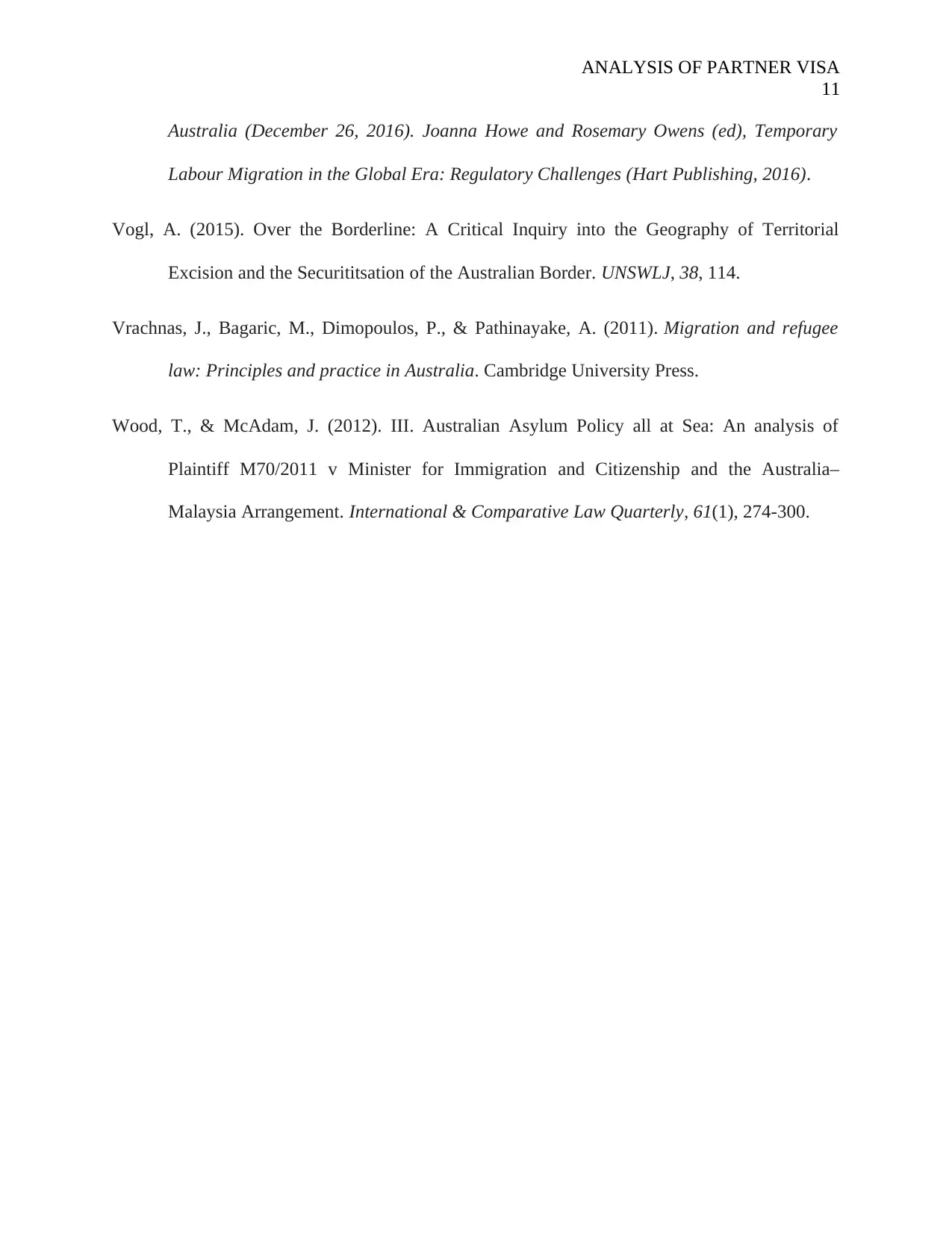
ANALYSIS OF PARTNER VISA
11
Australia (December 26, 2016). Joanna Howe and Rosemary Owens (ed), Temporary
Labour Migration in the Global Era: Regulatory Challenges (Hart Publishing, 2016).
Vogl, A. (2015). Over the Borderline: A Critical Inquiry into the Geography of Territorial
Excision and the Securititsation of the Australian Border. UNSWLJ, 38, 114.
Vrachnas, J., Bagaric, M., Dimopoulos, P., & Pathinayake, A. (2011). Migration and refugee
law: Principles and practice in Australia. Cambridge University Press.
Wood, T., & McAdam, J. (2012). III. Australian Asylum Policy all at Sea: An analysis of
Plaintiff M70/2011 v Minister for Immigration and Citizenship and the Australia–
Malaysia Arrangement. International & Comparative Law Quarterly, 61(1), 274-300.
11
Australia (December 26, 2016). Joanna Howe and Rosemary Owens (ed), Temporary
Labour Migration in the Global Era: Regulatory Challenges (Hart Publishing, 2016).
Vogl, A. (2015). Over the Borderline: A Critical Inquiry into the Geography of Territorial
Excision and the Securititsation of the Australian Border. UNSWLJ, 38, 114.
Vrachnas, J., Bagaric, M., Dimopoulos, P., & Pathinayake, A. (2011). Migration and refugee
law: Principles and practice in Australia. Cambridge University Press.
Wood, T., & McAdam, J. (2012). III. Australian Asylum Policy all at Sea: An analysis of
Plaintiff M70/2011 v Minister for Immigration and Citizenship and the Australia–
Malaysia Arrangement. International & Comparative Law Quarterly, 61(1), 274-300.
1 out of 11
Related Documents
Your All-in-One AI-Powered Toolkit for Academic Success.
+13062052269
info@desklib.com
Available 24*7 on WhatsApp / Email
![[object Object]](/_next/static/media/star-bottom.7253800d.svg)
Unlock your academic potential
Copyright © 2020–2025 A2Z Services. All Rights Reserved. Developed and managed by ZUCOL.





![Implications of Le v Minister for Immigration [2019] FCCA 2167](/_next/image/?url=https%3A%2F%2Fdesklib.com%2Fmedia%2Fimages%2Fyq%2F3867d1a1ba4b437ba61ecfd169b6d5a2.jpg&w=256&q=75)